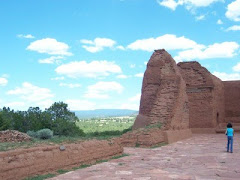
When we were in Tucson--an eight-hour drive from Santa Fe--last month, my nephew Brendan, a Border Patrol agent, took us to Nogales, Arizona (pop. 20,000) and into Nogales, Sonora (pop. 250,000). We parked the car at one of the lots on the American side ($4 a day), walked a few blocks, strolled through a gateway and checkpoint, and reached another country. A cacophonous, somewhat dirty country, with lots of people beseeching us to buy something, with what used to be known as "cripples" begging, with children begging. It's quite an unsettling experience, and certainly was for our kids. But we were with my other half, who has been twice to cities in China, and she began to bolt away. We followed her lead.
Within minutes we were past the Avenida Obregon area and into a section exponentially less fetid and quieter. The further we walked, the better it got. We recognize that it is only a border town, it is not Mexico. The difference as we went in a little further was the people. And this is what makes us sure that we will go back for a real visit.
In the town itself, I didn't have my camera, for once, and so I was able to concentrate on walking and looking around, rather than taking pictures. I liked that. There were lots of carts and burros, mostly for the tourists. We walked through a shaded alley that seemed friendly and pleasant, where our seven-year-old wanted to buy a wooden turtle. The seller was not pushy and had a gentle face. The turtle cost a dollar. Lucy clutched it for the remainder of our journey in the town, like a little security trinket.
The occasional zocalos, or squares, with a bit of shade or near a church, were the nicest locales. Eventually we found a modest but clean and well-tended restaurant, Las Marias, and the proprietor, a woman in her late forties, apparently took a shine to us, for we were treated like royalty. Everyone ate (homecooked food, including the tortilla chips) for nine dollars plus tip. My nephew, who speaks idiomatic Mexican/Spanish, found out the place really gets hopping at about two a.m., and said he might even go back.
When we began to return toward the U.S., the border fence loomed large on the hillside. It really is unsightly and almost embarassingly unfriendly. The queries of "You need some sunglasses?" and "Rolex watches aqui!" and "Fotografia con burro!" increased as we headed towards what relentless graffiti in Spanish all along the fence calls "a scar upon the land."
Before reentering the U.S., we had to stand in line for about twenty minutes. The Mexican people in front of and behind us were very cordial. One man was taking his son up to the border, where the boy was to go through on a return to school in Tucson. He looked sad. A very pretty young girl with kind eyes told Brendan that she has a resident permit and is working toward citizenship.
When we reached the checkpoint and were asked if we had anything to declare, Lucy placed her little turtle--about the size of a watch face--on the customs table for inspection. The agent, a woman, smiled broadly at its comical tininess and said, "That's it, huh?" She waved us through. For Americans, it's that easy. Brendan told us about his experiences chasing people who are trying to cross into the U.S. The agents have night vision goggles, they have batons and guns. What they don't have is sheer determination, adrenaline, and fear. He's dealt with drug runners. And he has retrieved bodies of young women still holding their babies in their arms.
Is the answer a high wall, but a wide gate? How will that work? The matter is not a simple one and you're kidding yourself if you think it is. We sure don't have the answers, and we do understand that there must be rules and limits--but it wasn't the Mexican side that felt hostile, unwelcoming, fearful, and offputting. I went in with some hostility myself, and many certainties, and came out with a heavy heart.








